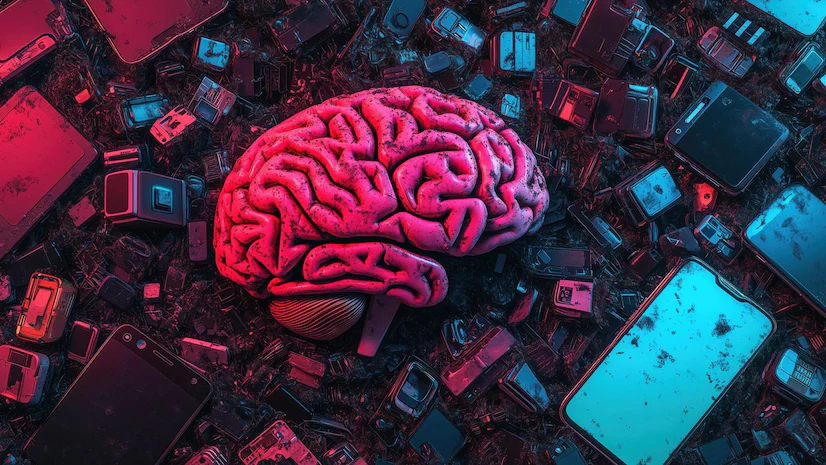In the age of endless scrolling and algorithm-driven content, a new internet phenomenon has emerged among the digital generation—brainrot culture. What started as a joke about feeling mentally fried after consuming too much online content has evolved into an entire aesthetic, humor style, and cultural identity. However, as brainrot becomes increasingly normalized across platforms like TikTok, Twitter, and Instagram, a crucial question arises: Is this just harmless fun, or are we overloading our minds in the process?
What Is Brainrot Culture?
The term brainrot originally came from online slang used to describe the mental exhaustion or numbness one feels after consuming an excessive amount of low-effort, chaotic, or absurd content. Over time, it’s become a kind of badge of honor—or even a personality trait—especially among Gen Z users. People now proudly refer to their “rotted” timelines, celebrate brainrot humor, and curate feeds filled with overstimulating, senseless media.
A classic example of brainrot content includes random, loud videos with distorted audio, deep-fried memes (heavily edited with filters), and strange AI-generated posts that make no coherent sense but go viral anyway. It’s not about quality or meaning—it’s about chaos, speed, and sensory overload.
The Evolution of Brainrot Online
Brainrot culture didn’t appear out of nowhere. It emerged as a response to the ever-increasing speed of digital media consumption and the saturation of content across social platforms. Platforms like Vine (RIP), TikTok, YouTube Shorts, and Reels conditioned users to expect constant entertainment in small, bite-sized packages. As a result, attention spans have shortened, and users now favor content that immediately grabs their attention, often by being loud, strange, or bizarre.
This trend was further amplified by meme communities, absurdist humor groups, and Gen Z’s dark, ironic take on the world. Many younger users turned to brainrot-style content not just for entertainment but as a form of emotional release or commentary on a world that often feels overwhelming and unpredictable.
Why People Love Brainrot Content
There’s no denying the appeal of brainrot content. It’s funny, weird, relatable, and it doesn’t ask much of you. You don’t need context. You don’t need to think. You just need to watch, laugh, scroll, and repeat.
In a way, it’s a reflection of how people cope with digital fatigue. Instead of resisting the chaos, brainrot embraces it. Instead of analyzing or processing content deeply, users let themselves be absorbed by the noise. It’s low-effort escapism with high dopamine rewards.
Brainrot also taps into a kind of collective humor and identity. When someone shares a brainrotted video or meme, it signals they’re part of a niche internet culture—a group that “gets it.” It fosters a sense of belonging in an increasingly fragmented digital world.
The Harmless Side: Creativity and Irony
Not all aspects of brainrot culture are negative. In fact, much of it is creative. Users remix sounds, visuals, and ideas to produce completely original content. The humor may be absurd, but it often requires sharp editing skills and a deep understanding of internet trends.
Many creators use brainrot to challenge conventional ideas of storytelling and humor. It’s fast, unpredictable, and full of inside jokes—perfect for a generation raised on hypertext, memes, and meta-commentary. Brainrot has even become an aesthetic of its own, influencing fashion, music videos, and art.
The Dark Side: Mental Fatigue and Burnout
Still, brainrot culture isn’t without consequences. As funny as the content might be, constant exposure to overstimulating media can affect mental health. Many users describe feeling mentally drained, anxious, or even dissociated after spending hours scrolling through chaotic videos and memes.
Over time, your brain may become so accustomed to high-speed, fragmented content that it struggles to engage with slower, more meaningful forms of media—like reading books, watching full-length films, or having deep conversations. This could contribute to attention deficit, lack of focus, and even emotional numbness.
Moreover, the humor in brainrot culture often leans toward nihilism, self-deprecation, or existential despair. While this can feel relatable, it may also reinforce negative thought patterns—especially among younger users who are already dealing with stress, uncertainty, or loneliness.
So, Is It Harmless Fun or Mental Overload?
Like many internet trends, brainrot culture isn’t inherently good or bad—it’s a reflection of the times. In moderation, brainrot content can be funny, comforting, and creatively fulfilling. But when it becomes your main form of entertainment, it might be time to step back and ask: Is this content feeding me, or is it draining me?
Taking breaks from overstimulating media, curating your feed with intention, and consuming slower, more thoughtful content can help restore balance. You don’t need to quit cold turkey—but developing media awareness is key.
Final Thought:
In the end, brainrot culture might just be the internet holding up a mirror to itself. It’s a coping mechanism, a shared language, and sometimes a cry for help. The key is knowing when it’s time to log off and give your brain a break—before it rots for real.



































